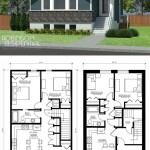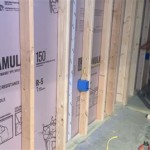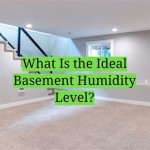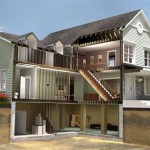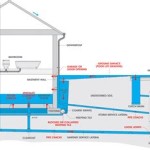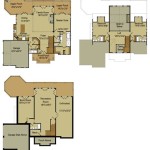What Is Best for Basement Flooring? A Comprehensive Guide
Selecting the appropriate flooring for a basement environment presents unique challenges compared to choosing flooring for above-ground living spaces. Basements are inherently prone to moisture, temperature fluctuations, and potential flooding, demanding resilient and water-resistant materials. Furthermore, comfort, aesthetics, and budget considerations play vital roles in the decision-making process. This article explores various basement flooring options, analyzing their strengths, weaknesses, and suitability for different basement scenarios.
The critical factor influencing the choice of basement flooring is moisture management. Concrete, the typical subfloor in basements, is porous and susceptible to moisture migration from the ground. This moisture can lead to mold growth, mildew, and damage to the flooring material and surrounding structure. Therefore, flooring materials must either be impervious to moisture or allow for proper ventilation and drainage. Choosing the right option involves careful consideration of the basement’s specific moisture conditions and the intended use of the space.
Moisture-Resistant Flooring Options
Several flooring materials are inherently resistant to moisture and suitable for basement applications. These options minimize the risk of water damage and provide a durable, long-lasting surface. These flooring solutions are most often used in basements due to the benefits they offer.
Ceramic and Porcelain Tile: Ceramic and porcelain tiles are excellent choices for basement flooring due to their inherent waterproof properties. They are non-porous and resistant to stains, scratches, and wear. Tile is available in a wide range of styles, colors, and sizes, allowing for diverse design options. Installation requires proper preparation of the subfloor, ensuring a level and stable surface. Grout lines, however, can be susceptible to staining and mold growth if not properly sealed and maintained. Tile can also be cold underfoot, necessitating the use of rugs or radiant heating systems for added comfort.
Luxury Vinyl Tile (LVT) and Luxury Vinyl Plank (LVP): LVT and LVP are popular choices for basements because they are waterproof, durable, and relatively easy to install. These materials consist of multiple layers, including a wear layer, a decorative layer, and a backing layer. The wear layer provides resistance to scratches and stains, while the decorative layer mimics the appearance of wood, stone, or tile. LVP typically comes in plank format, resembling hardwood flooring, while LVT is available in tile or plank formats. Installation can be done using glue-down, click-lock, or loose-lay methods, depending on the product and the subfloor conditions. It offers a cost-effective and aesthetically pleasing alternative to natural materials. It is recommended to ensure the product’s composition is 100% waterproof, as some LVT/LVP products are only water-resistant.
Sheet Vinyl: Sheet vinyl provides a seamless and waterproof flooring solution for basements. It comes in large rolls, minimizing the number of seams where moisture can penetrate. Sheet vinyl is relatively inexpensive and easy to install, making it a budget-friendly option. It is available in a variety of colors and patterns, but the design options may be more limited compared to tile or LVT/LVP. Proper subfloor preparation is crucial, as imperfections in the subfloor can telegraph through the vinyl. While durable, it is susceptible to punctures and tears from sharp objects.
Epoxy Flooring: Epoxy flooring is a durable, seamless, and waterproof option suitable for basements. It consists of a resin and a hardener that are mixed together and applied to the concrete subfloor, creating a hard, glossy surface. Epoxy flooring is resistant to chemicals, stains, and abrasion, making it ideal for basements used as workshops or garages. It is available in a variety of colors and finishes, including decorative flakes and metallic pigments. Installation requires careful surface preparation and professional application for optimal results. However, epoxy can be slippery when wet and may require the addition of a non-slip additive.
Flooring Options Requiring Moisture Mitigation
Certain flooring options are not inherently waterproof and require specific moisture mitigation strategies to be suitable for basement applications. These strategies involve creating a barrier between the concrete subfloor and the flooring material to prevent moisture damage. These flooring solutions often require more work to ensure that the basement area is properly set up to receive them.
Engineered Wood Flooring: Engineered wood flooring consists of a thin layer of hardwood veneer bonded to a core of plywood or high-density fiberboard (HDF). This construction provides greater dimensional stability compared to solid hardwood flooring, making it less susceptible to warping or cupping in humid environments. However, engineered wood flooring is not waterproof and requires a vapor barrier to prevent moisture from migrating from the concrete subfloor. A proper underlayment is also necessary to provide cushioning and reduce noise transmission. While offering the aesthetic appeal of hardwood, engineered wood flooring is more expensive than vinyl options and requires careful installation to ensure proper moisture protection.
Laminate Flooring: Laminate flooring consists of a photographic image of wood, stone, or tile bonded to a core of high-density fiberboard (HDF) and protected by a clear wear layer. It is a cost-effective alternative to hardwood flooring and is relatively easy to install using a click-lock system. Laminate flooring is water-resistant but not waterproof. It requires a vapor barrier to protect the core from moisture. Prolonged exposure to water can cause the HDF core to swell and delaminate. High-quality laminate flooring with a thicker wear layer provides greater durability and resistance to scratches and stains. It is important to select laminate flooring specifically designed for basement applications.
Carpet: Carpet provides warmth and comfort underfoot, making it a popular choice for basements used as living spaces or bedrooms. However, carpet is highly susceptible to moisture damage and mold growth. It should only be installed in basements with effective moisture control strategies in place. This includes a waterproof subfloor membrane, proper ventilation, and regular monitoring for leaks or condensation. Alternatively, carpet tiles can be used, allowing for easier replacement of damaged sections. Synthetic carpet fibers, such as nylon or polyester, are more resistant to moisture and mold than natural fibers like wool. It is recommended to choose low-pile carpets to minimize moisture retention.
Wood Subfloors: While not the final flooring layer, wood subfloors can be installed over a concrete slab to create a warmer and more comfortable base for carpet, laminate, or other flooring materials. However, wood subfloors require significant moisture mitigation measures. This includes a waterproof membrane between the concrete slab and the wood subfloor, as well as proper ventilation to prevent moisture buildup. Pressure-treated lumber should be used for the subfloor framing to resist rot and decay. Wood subfloors can raise the floor level significantly, potentially reducing headroom in the basement. This option is more expensive and labor-intensive compared to direct installation of moisture-resistant flooring.
Factors Influencing Flooring Selection
Beyond moisture resistance, several other factors influence the selection of the best basement flooring option. These factors encompass functionality, aesthetics, budget, and ease of installation.
Intended Use of the Space: The primary function of the basement space significantly impacts the flooring choice. A basement used as a home theater or playroom may benefit from the warmth and sound-absorbing properties of carpet. A basement used as a workshop or laundry room may require the durability and water resistance of epoxy flooring or tile. A basement used as a living area may benefit from the aesthetic appeal of LVT/LVP or engineered wood flooring. Consider the specific activities that will take place in the basement when making a flooring decision.
Budget Considerations: Basement flooring options vary significantly in price. Sheet vinyl and laminate flooring are generally the most affordable options, while tile, engineered wood flooring, and epoxy flooring are more expensive. Installation costs also vary depending on the complexity of the project and the need for professional assistance. It is essential to establish a budget and research the total cost of materials, installation, and any necessary subfloor preparation or moisture mitigation measures.
Ease of Installation: Some flooring options are easier to install than others. Click-lock LVT/LVP and laminate flooring are relatively simple to install as a do-it-yourself project. Tile, sheet vinyl, and epoxy flooring require more specialized skills and may be best left to professional installers. Consider personal skills and experience when deciding whether to tackle a flooring installation project independently or hire a professional.
Aesthetic Preferences: The aesthetic appeal of the flooring is also an important consideration. Basement flooring should complement the overall style and décor of the home. Options range from the natural look of wood or stone to the modern appeal of tile or epoxy flooring. Consider the color, pattern, and texture of the flooring to create the desired ambiance in the basement space.
In conclusion, selecting the best flooring for a basement requires careful consideration of moisture conditions, intended use, budget, ease of installation, and aesthetic preferences. By understanding the characteristics of different flooring options and implementing appropriate moisture mitigation strategies, homeowners can create a functional, comfortable, and aesthetically pleasing basement space that is protected from water damage and mold growth.

5 Best Flooring Options For Basements Floors2day

The Best Flooring Options For Your Basement From Forest Llc

What Is The Best Flooring For Basements Get Pros And Cons

What Are The Best Flooring For Basement In Homes

The Best Basement Flooring Options For Your Home

4 Of The Best Options For Basement Flooring In Your Home Reallycheapfloors America S Cheapest Hardwood

The 10 Best Basement Flooring Options Girl

Selecting The Best Basement Flooring Next Day Floors

The Best Flooring Options For Your Basement America

The Best Basement Flooring Options For Your Home
